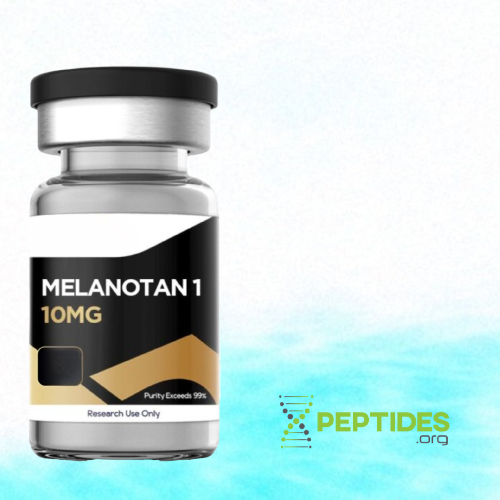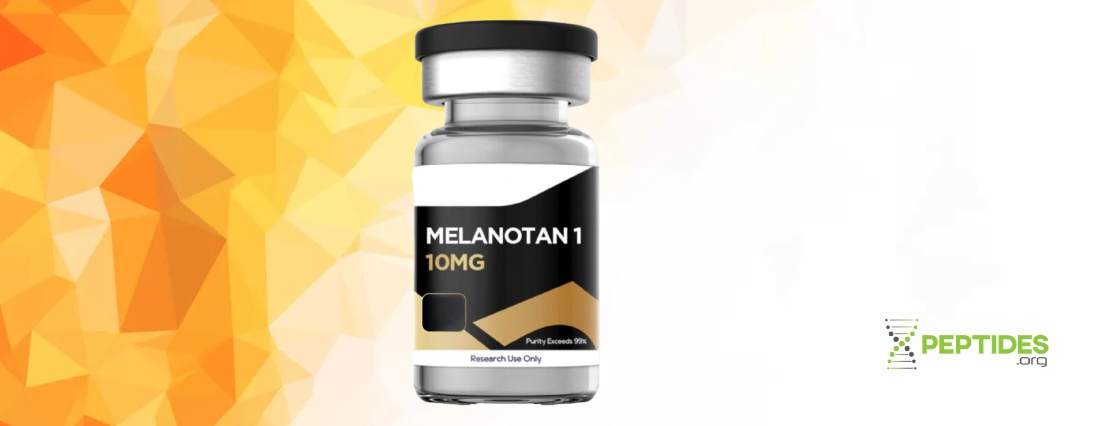Buy Melanotan 1 Online | The A-Z Guide

Melanotan 1 (MT-1) is a synthetic peptide and analogue of alpha-melanotocyte stimulating hormone, an agonist of melanocortin receptors 1, 3, 4, and 5. MT-1 was first developed as a sunless tanning agent, as its ability to bind to melanocortin receptor 1 causes skin to produce more melanin, turning it darker.
It is now approved as afamelanotide in both the United States and Europe to prevent sun-related skin damage in patients with erythropoietic protoporphyria. Most commonly used as a skin tanning agent, the peptide is also being investigated for its potential to treat conditions like vitiligo, rosacea, and erectile dysfunction.
Availability: In-Stock
Price: $29.00
- FREE Shipping for orders over $200 (USA Only)
- $9.25 Flat Rate Shipping, USA Orders
- Includes one 30mL Bacteriostatic Water with orders over $200

What is Melanotan 1?
Melanotan 1 (MT1) is a synthetic analogue of alpha-melanocyte-stimulating hormone (α-MSH), known for its role in activating melanogenesis, the process regulating pigmentation of the hair and skin. α-MSH is also known to regulate appetite and sexual desire [1].
Melanotan 1, is typically injected or administered as an implant, and binds to the melanocortin receptors 1, 3, 4, and 5 (MC1R, MC3R, MC4R, MC5R), with a strong effect on MC1R, leading to increased melanin production and tanning in test subjects [2, 3, 4, 5, 6].
Melanotan 1 has a linear formation and consists of 13 amino acids, just like endogenous α-MSH. But unlike α-MSH, MT1 has norleucine as its fourth amino acid and D-phenylalanine and its seventh amino acid [5]. In its modified form, MT1 is more potent and resistant to breakdown than endogenous α-MSH [7].
While this guide will focus on melanotan 1, researchers should be aware of the existence of the melanotan 2 (MT2) molecule, also studied for its effects on melanin production as well as on sexual desire, libido, and appetite [6].

Melanotan 1 Benefits | Clinical Trials
There is strong research interest in melanotan 1 and this section will summarize the main benefits of melanotan 1 as evidenced by these trials.
Increased melanin production and tanning
MT1 binds strongly to the melanocortin 1 receptor (MC1R), which is involved in the production of melanin, tyrosinase, and melanocyte [2, 3]. Studies have shown that melanotan 1 has a strong impact on both the rate of melanin production and tanning, effectively speeding up the tanning process and reducing the incidence of sunburnt cells in research subjects [4].
According to the findings of three phase I clinical trials conducted by dermatology clinics at the Arizona Health Sciences Center, test subjects who received MT1 injections tanned significantly more easily on their backs compared with the control group, and experienced a 47 percent reduction in sunburn on their necks after receiving small doses of UV-B light [4].
Psychological benefits in recovering patients
There is strong evidence that melanotan I offers psychological benefits such as improvements in both outlook and mood in patients recovering from various ailments.
- A phase II clinical trial involving patients who had received photodynamic therapy (PDT) found that melanotan 1 improved mood and outlook compared with the control group. The trial, sponsored by Clinuvel Pharmaceuticals, concluded that MT1 could potentially be used as a post-PDT treatment for patients in this population [8].
- Melanotan 1 has also been investigated as a treatment for patients who have undergone photodynamic therapy with porfimer sodium. According to a 2008 phase II multicentre, double-blind, placebo-controlled pilot study, patients who received melanotan 1 implants derived several psychological benefits including improvements in mood [8].
A follow-up trial has sought to evaluate the safety of subcutaneous bioresorbable implants of melanotan I but results from this trial are unavailable [9]. This provides researchers with several potential directions for future research involving MT1.
Potential treatment for acne vulgaris
There is strong research interest in melanotan 1 as a potential treatment of acne vulgaris and at least one phase 2 trial has already investigated the peptide for this purpose.
In a 2011 phase II randomized study, test subjects were administered melanotan 1 injections at either a three-week interval or two injections at one-month intervals. The study, conducted in Germany, found that patients who received subcutaneous bioresorbable melanotan 1 implants experienced an improvement in their quality of life (measured by DLQI) and a reduction in the number of inflammatory acne lesions on their faces. Further, subjects who received melanotan could spend up to seven times longer in the sun compared with the control group [10]. Results for a follow-up trial are currently unavailable [11].
Potential treatment for light sensitivity disorders
Melanotan 1 has been investigated as a potential treatment for a variety of rare light sensitivity disorders, including:
- Xeroderma pigmentosum (XP), a rare condition that causes extreme sensitivity to ultraviolet (UV) light;
- Polymorphic light eruption (PLE), where sunlight causes skin rashes; and,
- Erythropoietic Protoporphyria (EPP).
While research into the use of MT1 to treat these conditions is ongoing, results from phase II studies indicate that melanotan I holds promise.
- For example, a 2019 proof of concept, phase IIa open-label study conducted in Germany aimed to investigate the use of MT1 to treat XP. Researchers found that melanotan had a favorable safety profile [12], which led to a follow-up study that is currently ongoing [13].
- Likewise, a 2010 phase III, randomized, double-blind, placebo-controlled, parallel-group study undertaken in Europe found that MT1 reduced the severity of PLE when administered as a 16 mg implant over a four-month period [14].
- Lastly, a 2011 European study found that EPP patients treated with MT1 experienced a higher quality of life and less pain compared with a control group [15].
Melanotan 1 Side Effects
Melanotan 1 appears to cause few, if any, side effects in test subjects, and a number of phase II and phase III studies have found it to be safe and well-tolerated [8, 9, 10, 11, 12, 13, 14, 15]. Notably, no MT1 study to date has been discontinued for any reason.
That said, based on the available research, melanotan 1 administration can cause the following short-term side effects:
Is Melanotan 1 Safe?
Melanotan I is still treated as a research chemical and we thus cannot draw conclusions about its safety. It is sold for in vitro experimentation only.
Melanotan 1 administration has been linked to a limited number of adverse events [16]:
- Cousin et al. described a single case where MT I injection led to an incidence of eruptive melanocytic naevi [17], an effect also described by Evans-Brown et al. [18].
- According to Langan et al., there are a limited number of case studies where researchers have described cases of melanotan I use leading to changes in skin moles [19].
- Dreyer et al. described a case of a 40-year-old test subject who experienced priapism as a result of self-administering melanotan I [20].
Melanotan 1 safety remains an area for further research.
Melanotan 1 Dosage Calculator
There are no universally agreed-upon melanotan 1 dosage guidelines. That said, researchers may consult the above-cited trials for details of how it has been administered in the past.
In trials where melanotan 1 was administered as an implant, dosages have ranged from 0.08mg/kg to 0.16mg/kg per day for phase I studies. Phase II and phase III melanotan 1 studies conducted in Europe have lasted up to four months [8, 9, 10, 11, 12, 13, 14, 15].
To achieve tanning of the skin, most researchers appear to administer melanotan 1 pursuant to the following protocol:
- Daily Dosage: 0.25 mg to 2 mg, starting at the lower end of said range and gradually increasing dose as needed.
- Frequency: Administer once daily or EOD for the first week of study. Switch to once weekly or monthly injections once desired outcome is achieved.
- Study Duration: 7-14 days
- Maintenance Injections: To maintain desired tanning outcome, administer melanotan 1 injections on a weekly, biweekly, or monthly basis, depending on the subject.
- Notes: Based on this sample protocol, one 10mg melanotan 1 vial suffices for one melanotan tanning cycle.
Where to Buy Melanotan 1 Online? | 2024 Edition
There are plenty of vendors that sell melanotan 1. But in reality, very few of these companies actually deliver on their promises.
In light of this reality, here are a few guidelines to consider when choosing a melanotan 1 vendor:
- Do they ensure secure transactions? Look for vendors who take security seriously and protect customers’ personal data.
- Are there independent third-party reviews? Look to see what other researchers are saying about a vendor on review sites like Trustpilot.
- Is the product legitimate? Look for the vendors that publicly post certificates of analysis to prove that the melanotan 1 they sell is high quality.
In our team’s experience, the following vendor meets these standards and more.
Xcel Peptides
We endorse US-based Xcel Peptides for the following reasons:
- Open & Transparent: The company posts all third-party quality test results online, letting researchers verify the purity of any product prior to making a purchase.
- Great Prices: Xcel Peptides sells melanotan 1 7.5mg vials for just $29 each. Researchers can save an additional 10% when signing up for their email list.
- Wide Selection: Besides melanotan 1, Xcel Peptides sells a host of growth hormone secretagogues, cosmetic peptides, and peptide blends.
- Efficient Assistance: Researchers with any questions or concerns about the buying or ordering process will typically receive email-based assistance within one business day.
Buy from this vendor with confidence!
Buy research peptides from Polaris Peptides today...

FAQ
How to Reconstitute Melanotan 1
Melanotan I powder should be reconstituted using bacteriostatic or sterile water. Researchers should inject the correct quantity of water into the peptide vial and swirl it around until fully dissolved.
How is Melanotan 1 Delivered
Melanotan I powder should be injected subcutaneously into the fatty layer of tissue around the test subject’s belly button area.
How to Take Melanotan 1
When administered as a sunless tanning agent, melanotan I is administered via subcutaneous injection on a daily basis.

Bacteriostatic Water and Melanotan 1
Any researcher handling melanotan 1 must have the proper materials and supplies to conduct the study.
In order to correctly handle, prepare, and store research peptides, like melanotan 1, supplies like bacteriostatic water and alcohol prep pads are needed.
A high-level overview of materials and supplies a researcher may need include:
- Bacteriostatic Water
- Sterile Empty Glass Vials
- Large Needles + Syringes
- Insulin Syringes
- Alcohol Prep Pads
If a research does not have the required materials available, it is recommend to check authorized vendors when sourcing.
Melanotan 1 For Sale | Verdict
We have prepared this guide for researchers who are curious about where to buy melanotan 1 online. Above, we summarized the peptide’s research-backed benefits and side effects, and illuminated worthwhile directions for future research. There are clear opportunities for further research with MT1 to examine clinically significant endpoints, such as quality of life, reduced pain, and improved mood in patients afflicted by various skin and light-sensitivity conditions.
Researchers interested in further exploring melanotan 1 are advised to visit Xcel Peptides, the best peptide vendor on the market.
References
- Mahiques-Santos L. Melanotan [Melanotan]. Actas Dermosifiliogr. 2012 May;103(4):257-9. Spanish. doi: 10.1016/j.ad.2011.08.002. Epub 2011 Nov 1. PMID: 22051769.
- Hadley ME, Dorr RT. Melanocortin peptide therapeutics: historical milestones, clinical studies and commercialization. Peptides. 2006 Apr;27(4):921-30. doi: 10.1016/j.peptides.2005.01.029. Epub 2006 Jan 18. PMID: 16412534.
- Dorr RT, Dvorakova K, Brooks C, Lines R, Levine N, Schram K, Miketova P, Hruby V, Alberts DS. Increased eumelanin expression and tanning is induced by a superpotent melanotropin [Nle4-D-Phe7]-alpha-MSH in humans. Photochem Photobiol. 2000 Oct;72(4):526-32. doi: 10.1562/0031-8655(2000)072<0526:ieeati>2.0.co;2. PMID: 11045725.
- Dorr RT, Ertl G, Levine N, Brooks C, Bangert JL, Powell MB, Humphrey S, Alberts DS. Effects of a superpotent melanotropic peptide in combination with solar UV radiation on tanning of the skin in human volunteers. Arch Dermatol. 2004 Jul;140(7):827-35. doi: 10.1001/archderm.140.7.827. PMID: 15262693.
- Wikberg JE, Muceniece R, Mandrika I, Prusis P, Lindblom J, Post C, Skottner A. New aspects on the melanocortins and their receptors. Pharmacol Res. 2000 Nov;42(5):393-420. doi: 10.1006/phrs.2000.0725. PMID: 11023702.
- Ryakhovsky VV, Khachiyan GA, Kosovova NF, Isamiddinova EF, Ivanov AS. The first preparative solution phase synthesis of melanotan II. Beilstein J Org Chem. 2008;4:39. doi: 10.3762/bjoc.4.39. Epub 2008 Oct 30. PMID: 19043625; PMCID: PMC2587946.
- Ugwu SO, Blanchard J, Dorr RT, Levine N, Brooks C, Hadley ME, Aickin M, Hruby VJ. Skin pigmentation and pharmacokinetics of melanotan-I in humans. Biopharm Drug Dispos. 1997 Apr;18(3):259-69. doi: 10.1002/(sici)1099-081x(199704)18:3<259::aid-bdd20>3.0.co;2-x. PMID: 9113347.
- A Phase II, Multicentre, Double-blind, Placebo Controlled, Pilot Study to Evaluate the Safety and Efficacy of CUV1647 Administered as A Subcutaneous Bioresorbable 16mg Implant in Patients Undergoing Photodynamic Therapy (PDT) utilizing Porfimer Sodium – Results. (2020). Retrieved 14 May 2022, from https://www.clinicaltrialsregister.eu/ctr-search/trial/2008-002446-39/results
- A Multicentre, Randomized, Double-Blind, Placebo-Controlled Phase II Study to Evaluate the Safety and Efficacy of Subcutaneous Bioresorbable Implants of CUV1647 for the Prophylactic Treatment of Pr... (2020). Retrieved 14 May 2022, from https://www.clinicaltrialsregister.eu/ctr-search/search?query=2007-007015-89
- A Phase II, Randomized, Open Label Pilot Study to Evaluate the Efficacy and Safety of Two Dosage Regimens of Subcutaneous Bioresorbable Afamelanotide Implants in Patients with Mild to Moderate Acne Vulgaris. (2021). Retrieved 14 May 2022, from https://www.clinicaltrialsregister.eu/ctr-search/trial/2009-018024-15/results
- A Phase II, Randomized Pilot Study to Evaluate the Efficacy and Safety of Subcutaneous, Bioresorbable Afamelanotide Implants and Narrow-Band Ultraviolet B (NB-UVB) Light in the Treatment of Nonsegm... (2011). Retrieved 14 May 2022, from https://www.clinicaltrialsregister.eu/ctr-search/search?query=2011-000169-10
- A Phase III, randomized, double blind, placebo controlled, parallel group study, to evaluate the safety and efficacy of subcutaneous implants of afamelanotide (16 mg) in patients suffering from polymorphic light eruption (PLE). (2022). Retrieved 14 May 2022, from https://www.clinicaltrialsregister.eu/ctr-search/search?query=2009-017359-92
- A Proof of Concept, Phase IIa, Open Label Study to Evaluate the Safety and Efficacy of Subcutaneous Implants of Afamelanotide in Patients with Xeroderma Pigmentosum (XP). (2019). Retrieved 14 May 2022, from https://www.clinicaltrialsregister.eu/ctr-search/search?query=2019-000597-34
- A Proof of Concept, Phase IIa, Open Label Study to Evaluate the Safety and Efficacy of Subcutaneous Implants of Afamelanotide in Patients with Xeroderma Pigmentosum (XP). (2021). Retrieved 14 May 2022, from https://www.clinicaltrialsregister.eu/ctr-search/search?query=2021-003642-20
- A Phase III, Multicentre, Double-Blind, Randomized, Placebo-Controlled Study to Confirm the Safety and Efficacy of Subcutaneous Bioresorbable Afamelanotide Implants in Patients with Erythropoietic Protoporphyria (EPP). (2020). Retrieved 14 May 2022, from https://www.clinicaltrialsregister.eu/ctr-search/search?query=2009-011018-51
- Langan EA, Nie Z, Rhodes LE. Melanotropic peptides: more than just 'Barbie drugs' and 'sun-tan jabs'? Br J Dermatol. 2010 Sep;163(3):451-5. doi: 10.1111/j.1365-2133.2010.09891.x. Epub 2010 Jun 9. PMID: 20545686.
- Cousen P, Colver G, Helbling I. Eruptive melanocytic naevi following melanotan injection. Br J Dermatol. 2009 Sep;161(3):707-8. doi: 10.1111/j.1365-2133.2009.09362.x. Epub 2009 Jul 2. PMID: 19575725.
- Evans-Brown M, Dawson RT, Chandler M, McVeigh J. Use of melanotan I and II in the general population. BMJ. 2009 Feb 17;338:b566. doi: 10.1136/bmj.b566. PMID: 19224885.
- Langan EA, Ramlogan D, Jamieson LA, Rhodes LE. Change in moles linked to use of unlicensed "sun tan jab". BMJ. 2009 Jan 27;338:b277. doi: 10.1136/bmj.b277. PMID: 19174439.
- Dreyer BA, Amer T, Fraser M. Melanotan-induced priapism: a hard-earned tan. BMJ Case Rep. 2019 Feb 21;12(2):e227644. doi: 10.1136/bcr-2018-227644. PMID: 30796078; PMCID: PMC6388891.
There are no reviews yet. Be the first one to write one.
